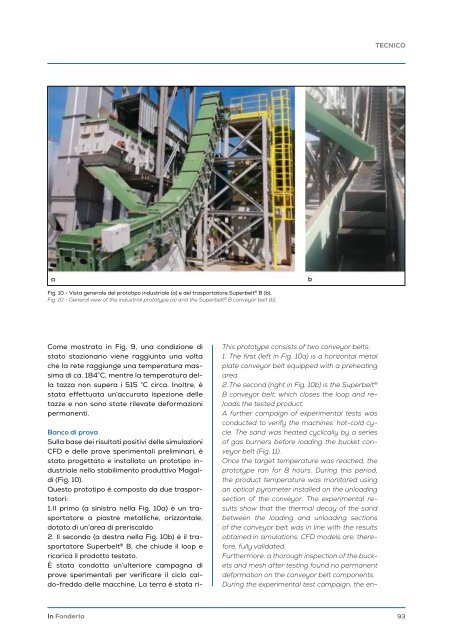In Fonderia 1 2024
Primo numero del 2024 di In Fonderia
Primo numero del 2024 di In Fonderia
You also want an ePaper? Increase the reach of your titles
YUMPU automatically turns print PDFs into web optimized ePapers that Google loves.
TECNICO<br />
Fig. 10 - Vista generale del prototipo industriale (a) e del trasportatore Superbelt ® B (b).<br />
Fig. 10 - General view of the industrial prototype (a) and the Superbelt ® B conveyor belt (b).<br />
Come mostrato in Fig. 9, una condizione di<br />
stato stazionario viene raggiunta una volta<br />
che la rete raggiunge una temperatura massima<br />
di ca. 184°C, mentre la temperatura della<br />
tazza non supera i 515 °C circa. <strong>In</strong>oltre, è<br />
stata effettuata un’accurata ispezione delle<br />
tazze e non sono state rilevate deformazioni<br />
permanenti.<br />
Banco di prova<br />
Sulla base dei risultati positivi delle simulazioni<br />
CFD e delle prove sperimentali preliminari, è<br />
stato progettato e installato un prototipo industriale<br />
nello stabilimento produttivo Magaldi<br />
(Fig. 10).<br />
Questo prototipo è composto da due trasportatori:<br />
1. Il primo (a sinistra nella Fig. 10a) è un trasportatore<br />
a piastre metalliche, orizzontale,<br />
dotato di un’area di preriscaldo<br />
2. Il secondo (a destra nella Fig. 10b) è il trasportatore<br />
Superbelt ® B, che chiude il loop e<br />
ricarica il prodotto testato.<br />
È stata condotta un’ulteriore campagna di<br />
prove sperimentali per verificare il ciclo caldo-freddo<br />
delle macchine. La terra è stata ri-<br />
This prototype consists of two conveyor belts:<br />
1. The first (left in Fig. 10a) is a horizontal metal<br />
plate conveyor belt equipped with a preheating<br />
area.<br />
2. The second (right in Fig. 10b) is the Superbelt ®<br />
B conveyor belt, which closes the loop and reloads<br />
the tested product.<br />
A further campaign of experimental tests was<br />
conducted to verify the machines’ hot-cold cycle.<br />
The sand was heated cyclically by a series<br />
of gas burners before loading the bucket conveyor<br />
belt (Fig. 11).<br />
Once the target temperature was reached, the<br />
prototype ran for 8 hours. During this period,<br />
the product temperature was monitored using<br />
an optical pyrometer installed on the unloading<br />
section of the conveyor. The experimental results<br />
show that the thermal decay of the sand<br />
between the loading and unloading sections<br />
of the conveyor belt was in line with the results<br />
obtained in simulations. CFD models are, therefore,<br />
fully validated.<br />
Furthermore, a thorough inspection of the buckets<br />
and mesh after testing found no permanent<br />
deformation on the conveyor belt components.<br />
During the experimental test campaign, the en-<br />
<strong>In</strong> <strong>Fonderia</strong><br />
93














